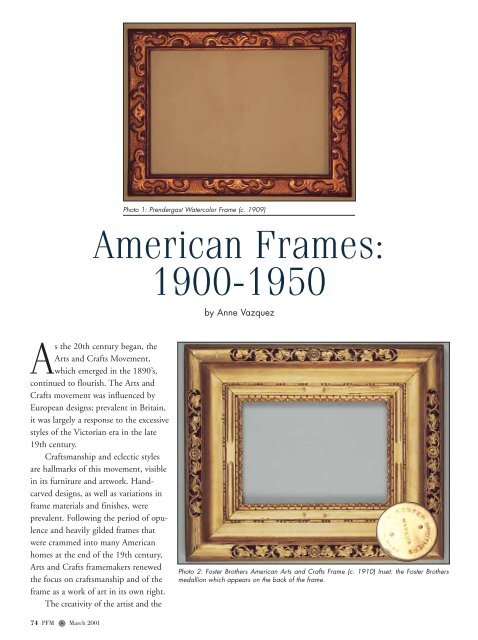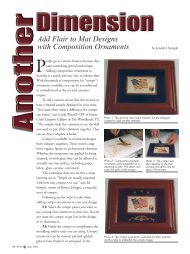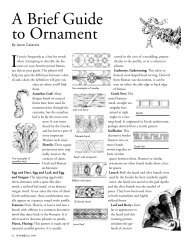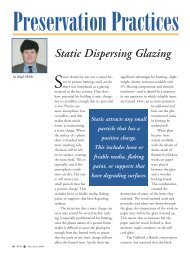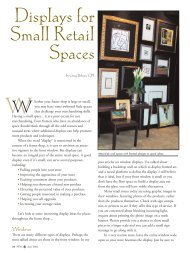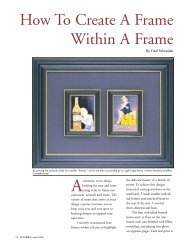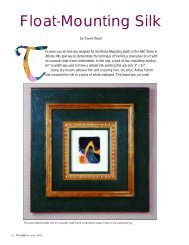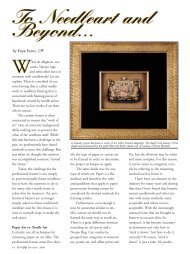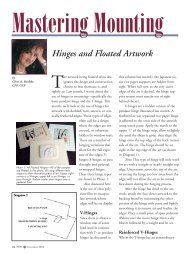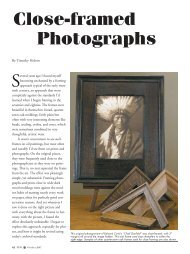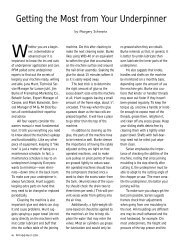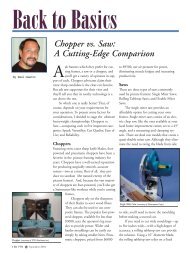American Frames: 1900-1950 - Picture Framing Magazine
American Frames: 1900-1950 - Picture Framing Magazine
American Frames: 1900-1950 - Picture Framing Magazine
You also want an ePaper? Increase the reach of your titles
YUMPU automatically turns print PDFs into web optimized ePapers that Google loves.
As the 20th century began, the<br />
Arts and Crafts Movement,<br />
which emerged in the 1890’s,<br />
continued to flourish. The Arts and<br />
Crafts movement was influenced by<br />
European designs; prevalent in Britain,<br />
it was largely a response to the excessive<br />
styles of the Victorian era in the late<br />
19th century.<br />
Craftsmanship and eclectic styles<br />
are hallmarks of this movement, visible<br />
in its furniture and artwork. Handcarved<br />
designs, as well as variations in<br />
frame materials and finishes, were<br />
prevalent. Following the period of opulence<br />
and heavily gilded frames that<br />
were crammed into many <strong>American</strong><br />
homes at the end of the 19th century,<br />
Arts and Crafts framemakers renewed<br />
the focus on craftsmanship and of the<br />
frame as a work of art in its own right.<br />
The creativity of the artist and the<br />
74 PFM _ March 2001<br />
Photo 1: Prendergast Watercolor Frame (c. 1909)<br />
<strong>American</strong> <strong>Frames</strong>:<br />
<strong>1900</strong>-<strong>1950</strong><br />
by Anne Vazquez<br />
Photo 2: Foster Brothers <strong>American</strong> Arts and Crafts Frame (c. 1910) Inset: the Foster Brothers<br />
medallion which appears on the back of the frame.
framemaker (who were often one<br />
and the same), directed the frame<br />
designs, rather than strictly traditional<br />
styles. In fact, a principle of<br />
the Arts and Crafts movement was<br />
to see the framemaker as an artist.<br />
As a result, the relationship between<br />
artists and the craftsman who built<br />
the frames for their art was particularly<br />
close in this period.<br />
The designs of Stanford White,<br />
which gained popularity at the end<br />
of the 19th century, continued to<br />
be appreciated for their classical<br />
motifs. His frames combined opulence<br />
with refinement in designs<br />
heavily based on Italian frames<br />
from the 15th century, and reflected<br />
his appreciation of styles from<br />
the Renaissance. His tabernacle<br />
frames, often made for artist Abbott<br />
Thayer’s paintings, are among his<br />
most well-known designs.<br />
The Prendergast brothers,<br />
Charles and Maurice, were also<br />
prominent in the <strong>American</strong> frame<br />
industry at the turn of the 20th<br />
century. While both men were<br />
artists, Charles’ strength was in<br />
framemaking, while Maurice<br />
excelled as an artist.<br />
Beginning around 1895,<br />
Charles made many frames for his<br />
brother’s artwork. In 1903,<br />
framemaker Hermann Dudley<br />
Murphy began the Carrig-Rohane<br />
firm in his studio in Winchester,<br />
Massachusetts. Charles Prendergast<br />
was his associate in the business.<br />
They moved the firm to Boston in<br />
1905 where their work helped to<br />
establish the city as a central loca-<br />
Photo 4: Arts and Crafts painting frame by Frederick Harer (c. 1915). Inset: Harer’s signed initials,<br />
FH, on the back of the frame.<br />
76 PFM _ March 2001<br />
Photo 3: An <strong>American</strong> Arts and Crafts frame made by Hermann Dudley Murphy/Carrig-Rohane<br />
framemakers. Inset: The hand-carved signature on the back of the frame.<br />
tion in the framemaking trade.<br />
The cassetta frame in Photo 3<br />
was made by Carrig-Rohane. It is<br />
made of wood, hand-carved, and<br />
gilded. Pastiglia was used to create<br />
the decorative pattern the panels.<br />
<strong>Frames</strong> made at Carrig-Rohane<br />
were given a hand-carved signature<br />
on the back (See inset of Photo 3).<br />
Charles Prendergast continued<br />
to gain popularity even after ending<br />
his partnership with Murphy<br />
and leaving Carrig-Rohane. In<br />
1914, he moved to New York City<br />
(another center of framemaking),<br />
funded by an order to make frames<br />
for portraits of past presidents of<br />
an insurance company.<br />
In the meantime, The Newcomb-Macklin<br />
Company, located<br />
in both New York and Chicago,<br />
also produced frames which were<br />
highly regarded. In addition to<br />
working with the Arts and Crafts<br />
designers, the company, which<br />
bought the rights to reproduce<br />
Stanford White’s designs after his<br />
assassination in 1906, worked with
Photo 5: Childe Hassam Frame<br />
(c. 1910-20)<br />
some artists in Taos, New Mexico.<br />
The influence of these relationships<br />
can be seen in many frames<br />
made by The Newcomb-Macklin<br />
Company up until the 1920’s.<br />
The Taos style incorporates<br />
hand-carved Native <strong>American</strong> and<br />
southwestern designs onto the<br />
frame. These frames were most<br />
often gilded. Eanger Irving Couse,<br />
an artist who founded the Taos<br />
School in New Mexico, often specified<br />
“Roman Gilding,” to be used<br />
on his frames. This technique used<br />
highly refined bronze powder<br />
78 PFM _ March 2001<br />
instead of bright gold, resulting in<br />
a low luster finish.<br />
In the West, San Francisco was<br />
another center of framemaking at<br />
the time. As both artists and<br />
framemakers, Arthur and Lucia<br />
Matthews produced hand-carved,<br />
polychromed and gilded frames to<br />
house their paintings. In the spirit<br />
of California, the Matthews often<br />
used motifs were flowers and fruits.<br />
Back East, Frederick Harer was<br />
also a prominent framemaker during<br />
the first quarter of the century.<br />
Located in New Hope, Pennsylvania,<br />
Harer was skilled in woodworking<br />
and used various techniques to<br />
decorate his frames, including stencilling,<br />
incising, matte and burnished<br />
gilding, and punchwork.<br />
The Harer frame in Photo 4 is<br />
a hand-carved wood frame that is<br />
gilded in silver (c. 1915). Prior to<br />
the Arts and Crafts period, silver<br />
was used for reasons of economy.<br />
<strong>Frames</strong> were often gilded in silver<br />
and then covered with shellac to<br />
create a gold tone for a gilded<br />
appearance. However, during the<br />
Arts and Crafts period, the turn<br />
Photo 6: A reproduction of Murphy Style<br />
Design<br />
Photo 7: A reproduction of an <strong>American</strong><br />
Impressionist Design
Photo 8: Modernist Frame (c. 1930’s-40’s)<br />
toward experimenting with materials<br />
and methods resulted in many<br />
framemakers using silver as the final<br />
finish of their frames.<br />
Another development was the<br />
use of red clay (bole) under the silver<br />
gilding. (Traditionally, blue or gray<br />
bole was most often used.) As a result<br />
of using the red bole, the tone of the<br />
frame was different than silver frames<br />
of the past, and this became another<br />
“<strong>American</strong>” technique.<br />
The Foster Brothers firm, established<br />
in 1875 by brothers John Roy<br />
and Stephen Bartlett, was a prominent<br />
framemaker in Boston during<br />
the first few decades of the 20th century.<br />
Known for their exemplary<br />
hand carving, many Foster Brothers<br />
frames were reminiscent of Dutch<br />
frames from previous centuries. They<br />
often featured rippled mouldings and<br />
Photo 9: Frame with cast ornament and painted<br />
(c. 1940-50)<br />
80 PFM _ March 2001<br />
special corner designs, which were<br />
then gilded with gold leaf.<br />
However, their style was not<br />
bound to those components, as can<br />
be seen in the Foster Brothers frame<br />
in Photo 2. While the elaborate hand<br />
carving and gilding has been used,<br />
there is an absence of corner design.<br />
After World War I, industry in<br />
America began to come into its own.<br />
Framemakers and artists alike began<br />
to draw on themes from industry,<br />
and while wood was the primary<br />
frame material, coatings other than<br />
gold came into favor<br />
in the 1920’s. These included silver<br />
(already being used steadily), chrome,<br />
and aluminum, as well<br />
as paint.<br />
Inevitably, the Art Deco period in<br />
the 1920’s influenced frame designs as<br />
well. While the style did not grow to<br />
dominate the craft, geometric shapes<br />
and elements reminiscent of Egyptian<br />
artifacts appeared on many panels at<br />
this time.<br />
During the 1930’s and 1940’s,<br />
marked changes in the economic,<br />
political, and social arenas also had<br />
some effect on the frames of the<br />
time—similar to the effect of World<br />
War I during the 1920’s. Styles were<br />
varied and what some call “freeform.”<br />
In contrast to traditional designs,<br />
there was a Modernist trend toward<br />
the various abstract styles, including<br />
Dadaism, Cubism, and Surrealism<br />
(see Photo 8). As the first half of the<br />
century came to a close, the mood in<br />
post-war America was shifting again,<br />
which would lead frame designs down<br />
yet another path—part of which took<br />
a turn towards minimalism. ■<br />
Photo credits—<br />
Photos 1, 2, 3, 4, and 8:<br />
Gill & Lagodich Fine Period <strong>Frames</strong><br />
Photo 10: Shaped wood frame with silver<br />
gilding (c. 1940)<br />
Photos 5, 9, and 10:<br />
Eli Wilner & Co.<br />
Photo 6 and 7:<br />
The Thanhardt Burger Corporation


